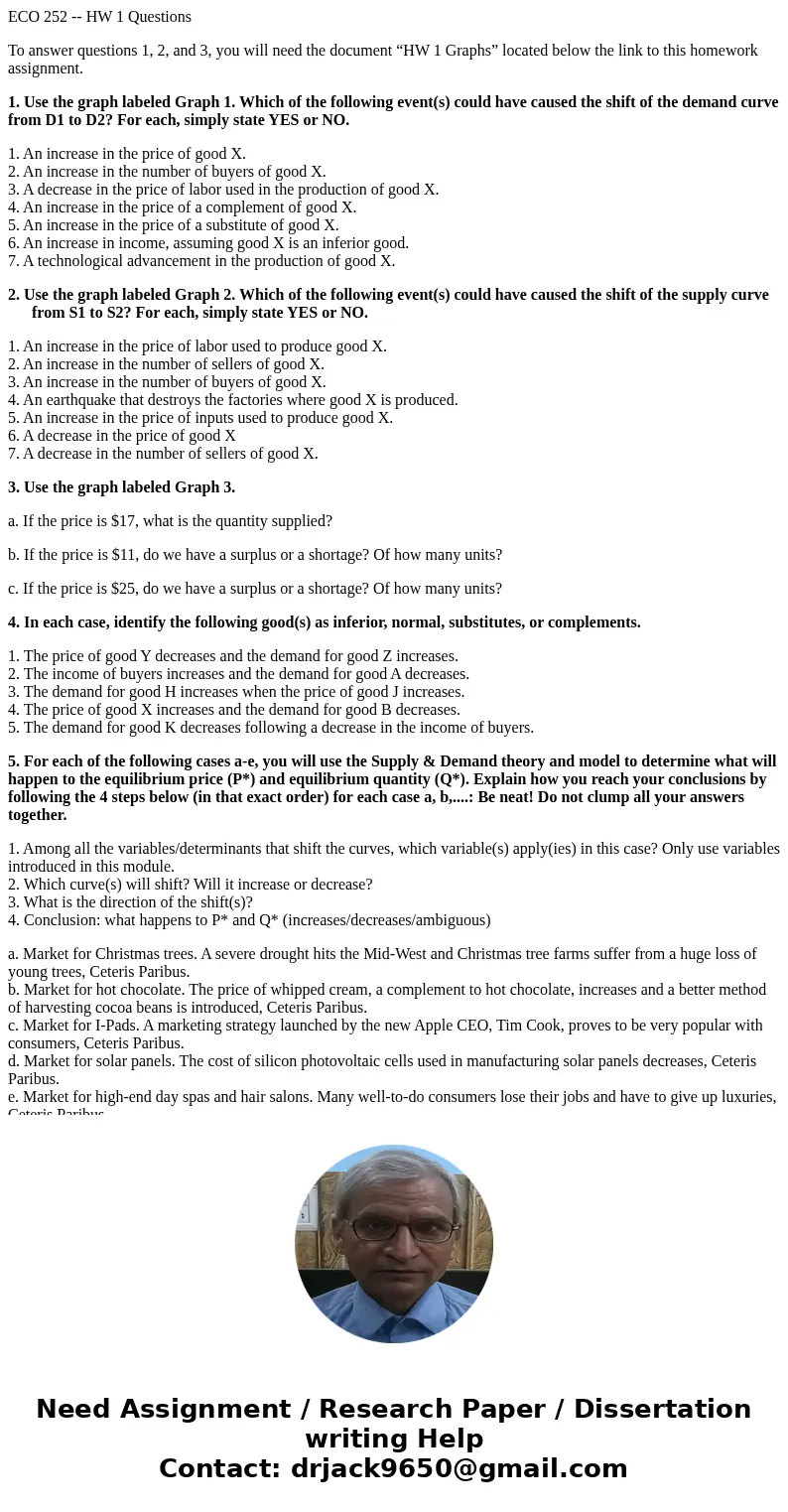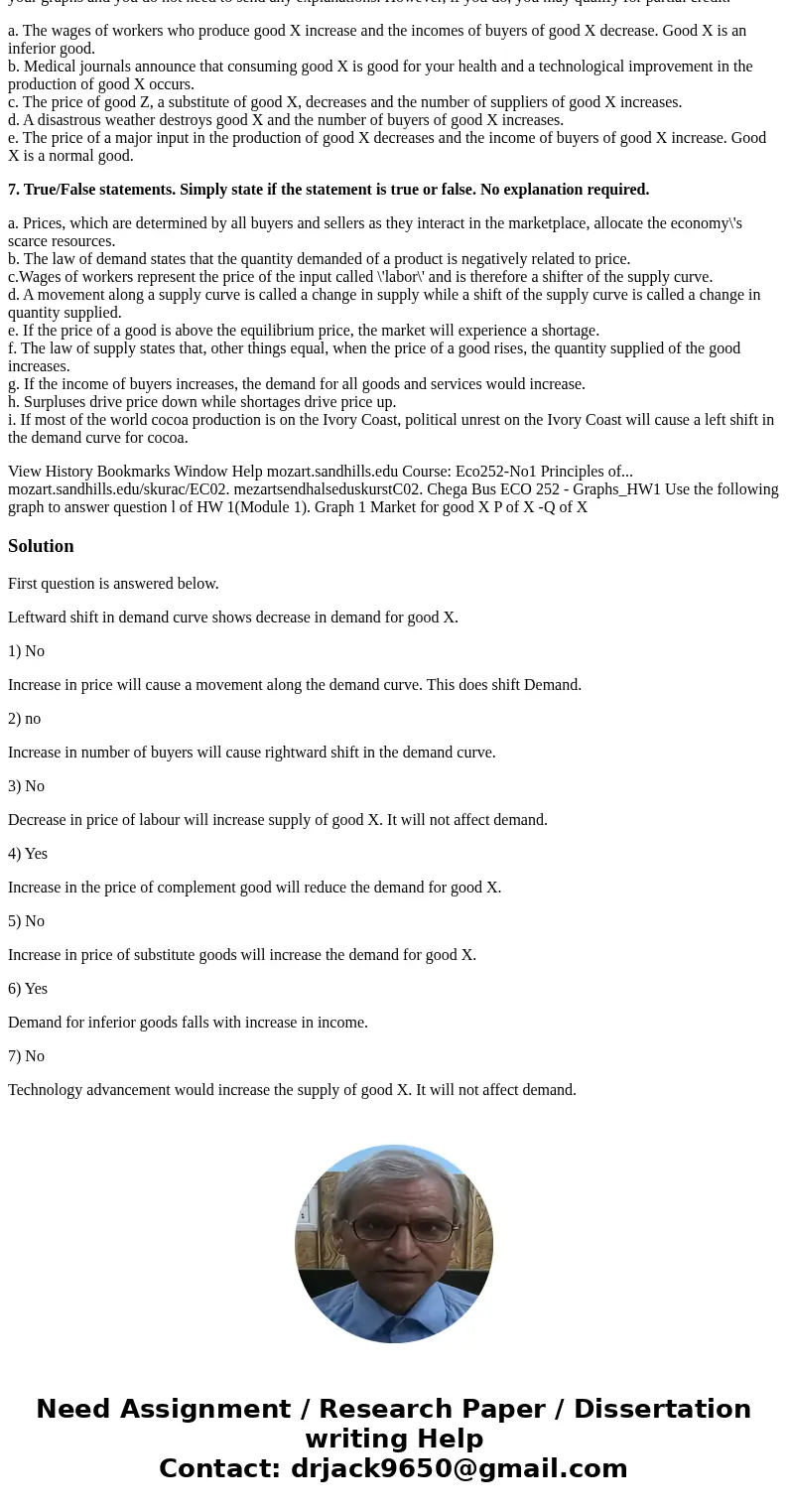ECO 252 HW 1 Questions To answer questions 1 2 and 3 you wi
ECO 252 -- HW 1 Questions
To answer questions 1, 2, and 3, you will need the document “HW 1 Graphs” located below the link to this homework assignment.
1. Use the graph labeled Graph 1. Which of the following event(s) could have caused the shift of the demand curve from D1 to D2? For each, simply state YES or NO.
1. An increase in the price of good X.
2. An increase in the number of buyers of good X.
3. A decrease in the price of labor used in the production of good X.
4. An increase in the price of a complement of good X.
5. An increase in the price of a substitute of good X.
6. An increase in income, assuming good X is an inferior good.
7. A technological advancement in the production of good X.
2. Use the graph labeled Graph 2. Which of the following event(s) could have caused the shift of the supply curve from S1 to S2? For each, simply state YES or NO.
1. An increase in the price of labor used to produce good X.
2. An increase in the number of sellers of good X.
3. An increase in the number of buyers of good X.
4. An earthquake that destroys the factories where good X is produced.
5. An increase in the price of inputs used to produce good X.
6. A decrease in the price of good X
7. A decrease in the number of sellers of good X.
3. Use the graph labeled Graph 3.
a. If the price is $17, what is the quantity supplied?
b. If the price is $11, do we have a surplus or a shortage? Of how many units?
c. If the price is $25, do we have a surplus or a shortage? Of how many units?
4. In each case, identify the following good(s) as inferior, normal, substitutes, or complements.
1. The price of good Y decreases and the demand for good Z increases.
2. The income of buyers increases and the demand for good A decreases.
3. The demand for good H increases when the price of good J increases.
4. The price of good X increases and the demand for good B decreases.
5. The demand for good K decreases following a decrease in the income of buyers.
5. For each of the following cases a-e, you will use the Supply & Demand theory and model to determine what will happen to the equilibrium price (P*) and equilibrium quantity (Q*). Explain how you reach your conclusions by following the 4 steps below (in that exact order) for each case a, b,....: Be neat! Do not clump all your answers together.
1. Among all the variables/determinants that shift the curves, which variable(s) apply(ies) in this case? Only use variables introduced in this module.
2. Which curve(s) will shift? Will it increase or decrease?
3. What is the direction of the shift(s)?
4. Conclusion: what happens to P* and Q* (increases/decreases/ambiguous)
a. Market for Christmas trees. A severe drought hits the Mid-West and Christmas tree farms suffer from a huge loss of young trees, Ceteris Paribus.
b. Market for hot chocolate. The price of whipped cream, a complement to hot chocolate, increases and a better method of harvesting cocoa beans is introduced, Ceteris Paribus.
c. Market for I-Pads. A marketing strategy launched by the new Apple CEO, Tim Cook, proves to be very popular with consumers, Ceteris Paribus.
d. Market for solar panels. The cost of silicon photovoltaic cells used in manufacturing solar panels decreases, Ceteris Paribus.
e. Market for high-end day spas and hair salons. Many well-to-do consumers lose their jobs and have to give up luxuries, Ceteris Paribus.
6. Which of the following, Ceteris Paribus, would cause an ambiguous change in the equilibrium price (P*) and an increase in the equilibrium quantity (Q*) of good X. For each, simply state YES or NO.
**Note that both the increase and the ambiguous change have to be satisfied and you cannot say YES to the first part and NO to the second part. It is strongly suggested that you draw the graphs to work out those shifts. You do not need to send your graphs and you do not need to send any explanations. However, if you do, you may qualify for partial credit.
a. The wages of workers who produce good X increase and the incomes of buyers of good X decrease. Good X is an inferior good.
b. Medical journals announce that consuming good X is good for your health and a technological improvement in the production of good X occurs.
c. The price of good Z, a substitute of good X, decreases and the number of suppliers of good X increases.
d. A disastrous weather destroys good X and the number of buyers of good X increases.
e. The price of a major input in the production of good X decreases and the income of buyers of good X increase. Good X is a normal good.
7. True/False statements. Simply state if the statement is true or false. No explanation required.
a. Prices, which are determined by all buyers and sellers as they interact in the marketplace, allocate the economy\'s scarce resources.
b. The law of demand states that the quantity demanded of a product is negatively related to price.
c.Wages of workers represent the price of the input called \'labor\' and is therefore a shifter of the supply curve.
d. A movement along a supply curve is called a change in supply while a shift of the supply curve is called a change in quantity supplied.
e. If the price of a good is above the equilibrium price, the market will experience a shortage.
f. The law of supply states that, other things equal, when the price of a good rises, the quantity supplied of the good increases.
g. If the income of buyers increases, the demand for all goods and services would increase.
h. Surpluses drive price down while shortages drive price up.
i. If most of the world cocoa production is on the Ivory Coast, political unrest on the Ivory Coast will cause a left shift in the demand curve for cocoa.
Solution
First question is answered below.
Leftward shift in demand curve shows decrease in demand for good X.
1) No
Increase in price will cause a movement along the demand curve. This does shift Demand.
2) no
Increase in number of buyers will cause rightward shift in the demand curve.
3) No
Decrease in price of labour will increase supply of good X. It will not affect demand.
4) Yes
Increase in the price of complement good will reduce the demand for good X.
5) No
Increase in price of substitute goods will increase the demand for good X.
6) Yes
Demand for inferior goods falls with increase in income.
7) No
Technology advancement would increase the supply of good X. It will not affect demand.



 Homework Sourse
Homework Sourse